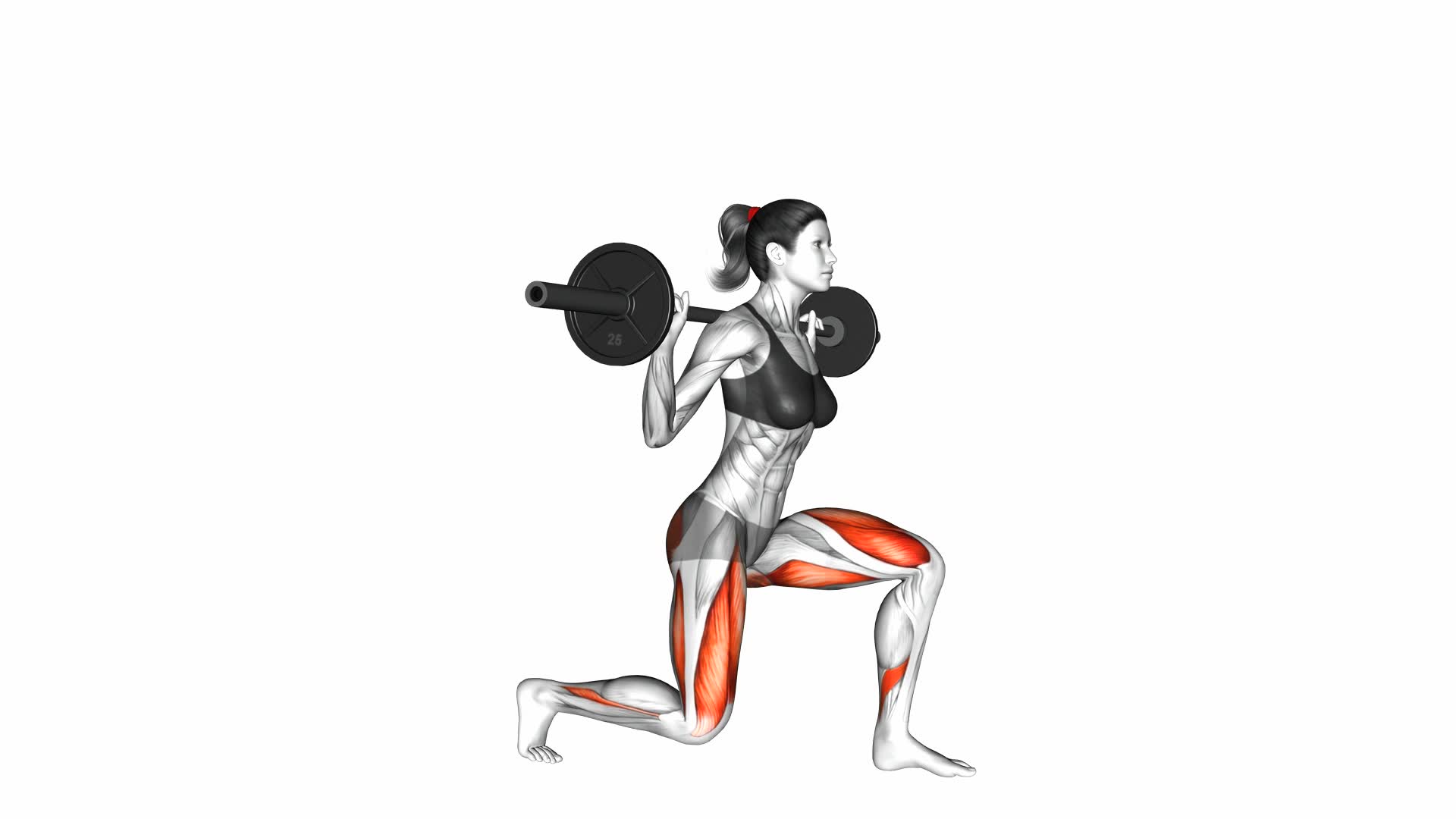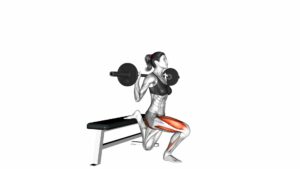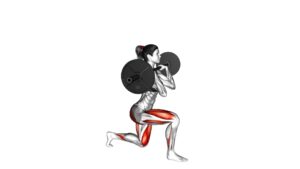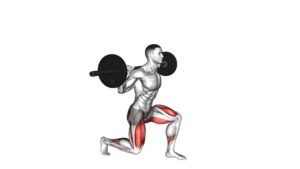Barbell Split Squat (female) – Video Exercise Guide & Tips

Are you looking for a challenging leg exercise to add to your routine? Look no further than the Barbell Split Squat!
Watch This Exercise Video
This video exercise guide and tips will show you how to properly perform the split squat with a barbell, targeting your glutes and quads for maximum effectiveness.
Whether you're a beginner or an advanced lifter, this exercise can be modified to suit your fitness level.
Get ready to amp up your lower body workout with the Barbell Split Squat!
Key Takeaways
- Barbell Split Squat targets glutes and quads for maximum effectiveness.
- It helps correct muscle imbalances and improve stability.
- The exercise isolates and strengthens glutes, quads, and hamstrings.
- It offers variations to target different muscle groups.
Benefits of the Barbell Split Squat
To maximize the effectiveness of your workouts, include the Barbell Split Squat in your routine for an enhanced lower body strength and stability.
The Barbell Split Squat is a powerful exercise that offers numerous benefits, particularly when it comes to unilateral training. Unilateral training refers to exercises that work one side of the body at a time, which can help correct muscle imbalances and improve overall stability.
By focusing on one leg at a time, the Barbell Split Squat helps to isolate and strengthen the muscles in your glutes, quads, and hamstrings. This exercise also helps to improve balance and coordination, as you're required to stabilize yourself on one leg while performing the movement.
Additionally, the Barbell Split Squat offers variations that can be incorporated into your routine to target different muscle groups. You can perform the exercise with dumbbells or a barbell, or even add an elevated platform for an increased challenge.
Equipment Needed for the Exercise
To perform the barbell split squat, there are a few pieces of essential equipment you'll need.
- Firstly, you'll need a barbell with weights that you can comfortably lift.
- Additionally, you'll need a squat rack or a sturdy bench to rest the barbell on.
If you don't have access to these specific items, don't worry! There are alternative equipment options that you can use to still get a great workout.
Essential Equipment for Split Squats
You will need two essential pieces of equipment for the split squat exercise: a barbell and a bench. The barbell is necessary to add resistance and challenge your muscles during the exercise. Look for reputable equipment brands that provide durable and high-quality barbells, such as Rogue Fitness or Eleiko.
A sturdy bench is also crucial for proper form and support. It should be adjustable to different heights so you can find the right position for your split squat. When choosing a bench, consider brands like Rep Fitness or PowerBlock, known for their durability and stability.
Now that you have the necessary equipment, let's move on to discussing alternatives to traditional equipment for split squats.
Alternatives to Traditional Equipment
If you don't have access to a barbell and bench, there are alternative equipment options you can use for the split squat exercise. Don't let the lack of traditional equipment stop you from reaping the benefits of this fantastic exercise.
One alternative exercise you can try is the bodyweight split squat. This variation allows you to work on your balance and stability while targeting your glutes, quads, and hamstrings.
Another option is using dumbbells or kettlebells as resistance. Simply hold the weights at your sides while performing the split squat. This adds an extra challenge to the exercise and helps increase strength and muscle tone.
Step-By-Step Guide to Performing the Barbell Split Squat
Let's get started with the step-by-step guide to performing the barbell split squat.
To ensure proper form, make sure your front foot is positioned a few feet in front of the barbell and your back foot is elevated on a bench or step.
As you lower your body down, focus on keeping your front knee in line with your toes and maintaining a straight back.
Proper Form Tips
How can you perform the barbell split squat with proper form? Follow these tips for a successful and effective workout:
- Start by standing with your feet hip-width apart and a barbell resting on your upper back.
- Take a big step forward with one foot and lower your body into a lunge position, making sure your front knee is directly above your ankle.
- Keep your back straight and core engaged throughout the movement.
- Push through your front heel to return to the starting position.
- Repeat the movement on the other side.
Common mistakes to avoid include leaning too far forward, not keeping your core tight, and allowing your knees to extend past your toes.
For beginners, it's recommended to start with bodyweight split squats or use lighter weights until you feel comfortable with the movement.
Remember to always prioritize proper form to maximize the benefits of this exercise.
Benefits of Exercise
To maximize the benefits of the barbell split squat, focus on building strength and stability in your lower body. This exercise not only targets your quadriceps, hamstrings, and glutes, but also improves your overall balance and coordination.
Before you start, it's important to warm up your muscles with dynamic stretches and mobility exercises to reduce the risk of injury. By incorporating a warm-up routine into your workout, you increase blood flow to your muscles and prepare them for the physical demands ahead.
Additionally, regular exercise has been shown to have positive effects on mental health. It can reduce symptoms of anxiety and depression, improve mood, and boost self-esteem. So, not only will the barbell split squat help you achieve a stronger lower body, but it will also contribute to your overall well-being.
Now, let's dive into some common mistakes to avoid while performing this exercise.
Common Mistakes to Avoid While Doing the Exercise
Avoid these three common mistakes when performing the Barbell Split Squat to ensure proper form and maximize the effectiveness of your workout:
- Incorrect foot placement: One of the most common mistakes is placing your front foot too far forward or too far back. To maintain proper form, make sure your front foot is directly under your knee and your back foot is positioned behind you with your heel off the ground.
- Leaning forward: Another mistake is leaning forward during the exercise. This puts excessive strain on your lower back and reduces the effectiveness of the squat. Instead, keep your torso upright and engage your core muscles to maintain stability.
- Lack of control: Rushing through the movement without proper control can lead to poor form and potential injuries. Take your time and focus on maintaining a slow and controlled descent, making sure to engage your glutes and quadriceps throughout the entire range of motion.
- Not using the barbell for stability: The barbell placed on your back should be used for stability and balance. Avoid using excessive weight that causes you to lose control or compromises your form.
- Neglecting the back leg: Many people tend to forget about the back leg during the split squat. To maximize the benefits of the exercise, focus on driving through the heel of your front foot and maintaining tension in your back leg.
By avoiding these common mistakes and performing the Barbell Split Squat with proper form, you'll engage the targeted muscles effectively and reduce the risk of injury.
Now, let's move on to the next section to learn some tips to increase the intensity of the barbell split squat.
Tips to Increase the Intensity of the Barbell Split Squat
To increase the intensity of your Barbell Split Squat, incorporate additional weight or resistance into your routine.
There are several ways to modify the barbell split squat and add more challenge to your workout.
One option is to increase the weight on the barbell. Start with a weight that's challenging but still allows you to maintain proper form. As you become stronger, gradually increase the weight to continue challenging your muscles.
Another way to intensify the exercise is to use dumbbells or kettlebells instead of a barbell. Holding the weights in each hand will engage your core and upper body more, making the exercise more demanding.
Additionally, you can try variations of the split squat to target different muscle groups. For example, you can perform a Bulgarian split squat by elevating your back foot on a bench or step. This variation places more emphasis on your glutes and hamstrings.
Remember to always listen to your body and adjust the weight and variations according to your fitness level. Push yourself, but also maintain proper form and technique to prevent injury and get the most out of your workout.
Modifications for Beginners and Advanced Lifters
For beginners and advanced lifters, there are various modifications available to enhance the effectiveness of the Barbell Split Squat exercise. Whether you're just starting out or looking to take your training to the next level, these modifications can help you target different muscle groups, improve stability, and increase overall strength.
Here are some beginner modifications to consider:
- Bodyweight Split Squats: Start by performing the exercise without any weights to focus on proper form and balance. This will help you build a solid foundation before adding weight.
- Elevated Rear Foot: Place your rear foot on a step or bench to increase the range of motion and target your glutes and hamstrings more effectively.
- Dumbbell Split Squats: Hold a dumbbell in each hand to add resistance and challenge your muscles further.
For advanced lifters, here are some modifications to increase the difficulty of the exercise:
- Barbell Split Squats: Instead of using dumbbells, hold a barbell across your upper back to increase the load and activate more muscle fibers.
- Bulgarian Split Squats: Elevate your rear foot on a bench or step, and perform the exercise with one leg at a time. This variation further challenges your balance and stability.
Frequently Asked Questions
How Many Calories Does the Barbell Split Squat Burn?
The barbell split squat is a great exercise for burning calories and targeting multiple muscle groups. By incorporating this exercise into your workout routine, you can torch calories and build strength in your legs, glutes, and core.
This compound movement engages your quads, hamstrings, and glutes, helping you build lean muscle and increase your overall calorie burn.
Can the Barbell Split Squat Help Improve Balance and Stability?
Improving stability is crucial for your fitness journey. The barbell split squat can be a game-changer.
By incorporating this exercise into your routine, you'll reap the benefits of increased balance and stability. The barbell split squat targets your leg muscles, core, and glutes, making them stronger and more resilient.
This enhanced stability won't only improve your performance during workouts but also in everyday activities. Get ready to step up your game and feel more confident in your movements.
Are There Any Alternative Exercises That Target the Same Muscle Groups as the Barbell Split Squat?
Looking for alternative exercises that target the same muscle groups as the barbell split squat? Well, you're in luck! There are several options you can try.
Lunges, Bulgarian split squats, and step-ups are all great alternatives that engage similar muscles. Incorporating these exercises into your routine will help you build strength and stability in your lower body.
Is It Recommended to Use a Weightlifting Belt While Performing the Barbell Split Squat?
Using a weightlifting belt while doing barbell split squats is a personal choice. Some people find it beneficial for added support and stability, especially when lifting heavy weights. Weightlifting belts can help maintain proper form and prevent injury by providing extra core stability.
However, it's important to remember that a weightlifting belt shouldn't be used as a substitute for proper technique and strength development. Ultimately, it's up to you to decide if using a belt enhances your workout experience.
How Often Should the Barbell Split Squat Be Incorporated Into a Workout Routine for Optimal Results?
To achieve optimal results, it's important to consider the frequency of incorporating the barbell split squat into your workout routine.
The barbell split squat is a powerful exercise that targets multiple muscle groups and can be done in various ways to keep it challenging and effective.
By including this exercise regularly, you'll not only build strength and stability, but also enhance your overall athletic performance.
Conclusion
Incorporating the barbell split squat into your workout routine can provide numerous benefits. These include increased leg strength, improved balance, and enhanced muscle definition.
By following the step-by-step guide and avoiding common mistakes, you can ensure proper form and maximize the effectiveness of this exercise.
To further challenge yourself, try incorporating tips to increase the intensity. Whether you're a beginner or an advanced lifter, modifications are available to suit your fitness level.
So grab a barbell and get ready to take your leg workout to the next level!

Author
Years ago, the spark of my life’s passion ignited in my mind the moment I stepped into the local gym for the first time. The inaugural bead of perspiration, the initial endeavor, the very first surge of endorphins, and a sense of pride that washed over me post-workout marked the beginning of my deep-seated interest in strength sports, fitness, and sports nutrition. This very curiosity blossomed rapidly into a profound fascination, propelling me to earn a Master’s degree in Physical Education from the Academy of Physical Education in Krakow, followed by a Sports Manager diploma from the Jagiellonian University. My journey of growth led me to gain more specialized qualifications, such as being a certified personal trainer with a focus on sports dietetics, a lifeguard, and an instructor for wellness and corrective gymnastics. Theoretical knowledge paired seamlessly with practical experience, reinforcing my belief that the transformation of individuals under my guidance was also a reflection of my personal growth. This belief holds true even today. Each day, I strive to push the boundaries and explore new realms. These realms gently elevate me to greater heights. The unique combination of passion for my field and the continuous quest for growth fuels my drive to break new ground.



